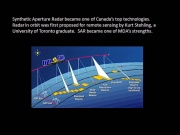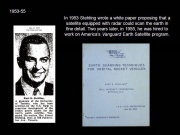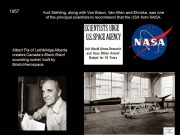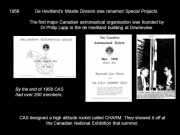100 Years of Aerospace History in Canada: From McCurdy to Hadfield Part 4 by Robert Godwin
From The Space Library
Space Based Radar, Black Brant Rockets and the Churchill Rocket Range
In 1953, while on short leave from Bell Aircraft, at the James Forrestal Research Center in Princeton New Jersey, Kurt Stehling published a paper in which he described the advantages of using space-borne radar to "paint the surface of the Earth" and transmit the data back to the ground for study.[i]
Stehling delivered his paper, entitled Earth Scanning Techniques for Orbital Rocket Vehicles, on January 26th 1953 at a technical session of the American Rocket Society (ARS) in New York. He compared both optical and microwave systems, concluding that the optical systems at that time had the weight and resolving power advantage, but the microwave radar system didn't rely on daylight or good weather.[ii]
In the years ahead space radar mapping technology would become one of Canada's main fortés in space science and astronautics.
In July 1955 James Van Allen and Stehling's rockoons would be covered in Time magazine. Five months later Stehling was recruited by the US Navy to work on their proposed earth satellite program.[iii] In 1956 the US government, in conjunction with the Canadian Defense Research Board (CDRB) announced that rockoons would be fired from ships in Frobisher Bay, and from Fort Churchill Manitoba and Baffin Island to study the upper atmosphere.[iv]
Indirectly, Stehling was bringing about the very role in space science that he had advocated for Canada back in 1948. He continued his swift ascent in the US space program and would establish a reputation for many progressive ideas, including inflatable space station modules.
Stehling was also the first to suggest that women astronauts, given equal training, would make better astronauts both physically and psychologically.[v]
Perhaps most importantly, he also contributed to the establishment of a US national space agency. Stehling was on the Rocket and Satellite Research Panel (along with Wernher von Braun[vi], Krafft Ehricke, James van Allen, Ernst Stuhlinger, Fred Whipple and others) which urged U.S. President Eisenhower in 1957 to form NASA.[vii]
Canada had played an important role in the two International Polar Year's and so, along with many other countries, Canadian researchers recognized the importance of contributing to the proposed International Geophysical Year. In this regard Canada already offered a convenient vantage point for studying the high northern latitudes and particularly the Earth's magnetic field. Therefore an arrangement was made in 1955 to establish a permanent scientific research establishment at Fort Churchill, with funding provided by the US Army.
The location selected at the mouth of the Churchill River had been used for vital observations as early as 1769 when astronomers William Wales and Joseph Dymond from the Royal Society traveled there to record a transit of Venus across the Sun. Wales and Dymond built two observatories at the Prince of Wales Fort which they used for the event.[viii] 186 years later the Churchill Research Range came into existence as one of the world's key places for launching sounding rockets to the ionosphere and beyond.
The following year, just before the launch of Sputnik 1, the Canadian Armament Research and Development Establishment (CARDE) commissioned a domestic rocket program which would eventually be named Black Brant.
This design and development program was to be undertaken by a Canadian based branch supplier of components to the Air Force's CF-100 interceptor program, named the British Bristol Aeroplane Company. The Black Brant rocket, designed by Albert Fia of Alberta, would be the nearest thing to a space launcher that Canada would develop and over the next decade would become one of the two most expensive programs undertaken in Canadian space research.[ix]
The launch facilities at Churchill would quickly evolve and be able to accommodate a variety of medium size US-built rockets including the Arcas, Nike, Apache, Tomahawk, Astrobee, Aerobee and Javelin as well as the Canadian built and rapidly evolving Black Brant.
While things were getting up to speed at Churchill, back at Downsview Dr Phil Lapp, an engineer at DeHavilland, recognized the need for Canada to become more involved in the new science of astronautics. Immediately following the launch and consequent political shock of Sputnik 1, Lapp arranged for his colleagues at Downsview to start an informal astronautical group which he dubbed, The Canadian Astronautical Society (CAS).
The group had their first meeting on January 8th 1958 at the Special Projects office of DeHavilland in Downsview.[x] Over the next two years many meetings of the CAS took place, usually with invited guest speakers. One such speaker that Dr Lapp remembered with fondness was his old mentor Dr Charles Draper, the famed MIT scientist. In 1950 Lapp had earned one of the coveted positions to study for his graduate work at Draper's labs in the United States.
One of the first coordinated projects undertaken by Lapp's CAS was their participation in Operation Moonwatch, the Smithsonian Astrophysical Observatory study of the orbits of satellites. Members of the CAS stood out on the cold rooftop at DeHavilland in Downsview during the course of 1958 taking measurements and timings of the over-flights of Sputnik III, Explorer 1, Explorer IV and their various boosters. They published their findings in October 1958.
The CAS also published several other papers, most notably Project CHARM (Canadian High Altitude Research Missile) and Project CLAMP (Canadian Lunar Antenna Moon Probe) which was a proposal for a sort-of mini Arecibo radio telescope for studying the moon's surface; to be built in a natural bowl near Guelph, Ontario.
Footnotes
[i] New York Times, Aug 6 1953
[ii] Journal of the American Rocket Society Mar-Apr 1953
[iii] Globe and Mail December 14th 1955
[iv] Ibid. April 12th 1956
[v] Milwaukee Journal Sep 6 1955
[vi] Von Braun and British Interplanetary Society Chairman Arthur C. Clarke had both been on a multi-year program to persuade the residents of the USA and UK that space flight was inevitable. Both also published extensive prognostications in Canada, Clarke in 1947 in the Toronto Star and von Braun in 1956 in MacLeans Magazine.
[vii] New York Times Jul 30 1955, Dec 13 1957, Apr 10 1960
[viii] http://gallica.bnf.fr/ark:/12148/bpt6k55864n/f509.pagination
[ix] Upper Atmosphere and Space Programs in Canada, Chapman, Lapp, Patterson, Forsyth, Science Secretariat, 1967
[x] Phil Lapp Memoir Pg 117




